| Author |
 Topic Topic  |
|
|
Palihh
 
17 Posts |
 Posted - 05/21/2024 : 12:35:04 Posted - 05/21/2024 : 12:35:04


|
Question about vertical mode.
The field is divided into 3 parts.
The lower field is the recorded peak value over the full range from 0.1-1 GHz. This is all clear.
In the middle field, as I understand it, the average value is shown over the full range from 0.1-1 GHz.
But there is a big question about the top margin. There, as I understand it, the current measured value at the specified frequency is shown.
But how does the device select this frequency?
Why is data shown at this particular frequency?
If he had chosen the maximum measured value at each specific moment in time and indicated the frequency at which this measurement was made, then there would have been no questions.
And this would be quite logical:
the upper field is the maximum value indicating the frequency at which it is recorded,
the middle field is the average value over the full range,
and the bottom field is the maximum peak.
Isn’t it logical to output data this way in Vertical mode?
In reality, this is not at all the case.
For example, there is a spike in the value, the upper field does not reflect it (at this moment it shows some frequency with minimal measurement), and only in the middle field does a slight increase in the average measurement appear.
I think this can be improved with new firmware.
Or I'm wrong? |
Edited by - Palihh on 05/21/2024 12:36:30
|
|
| Reply #1
Palihh
 
17 Posts |
 Posted - 05/23/2024 : 03:44:48 Posted - 05/23/2024 : 03:44:48


|
Let me clarify something.
In the “Unexplained radio frequency jump”, I tried to find out what device they were coming from.
And I was unable to do this either in the mode "RF browser" or in "Vertical mode".
In the mode "RF browser" there is no information at all about the frequency at which the current values are measured. And in "Vertical mode", this jump is not registered at all in the top field, which is visible in the "RF browser".
I'll clarify further.
The culprit for those spikes in RF field values was the smartphone and those spikes were not reflected in the top field in "Vertical mode".
However, when I turned on my walkie-talkie to transmit a signal at a frequency of 433 MHz, then in "Vertical mode", an increased value from the walkie-talkie was displayed in the upper field and the transmission frequency was indicated. From this I draw the following conclusion. Information from some sources is recorded in "Vertical mode" in the upper field in real time, indicating the frequency at which the measurement was taken, but from other sources such information is not recorded and displayed in the upper field!?
Thus, I conclude that the top margin in "Vertical mode" works in a very reduced and truncated manner!
I return to the wish, which I hope all users will support, and manufacturers will try to implement this in the next firmware if possible.
If, when monitoring RF radiation, an increased value is determined, then it would be very reasonable in ALL cases, I emphasize, IN ALL cases, to see at what frequency the jump in values occurred in real time!
Even if not in all modes, there should be AT LEAST ONE such mode (RF browser or vertical mode), in which the CURRENT FREQUENCY AND MEASURED VALUE would always be displayed in real time TOGETHER in the ENTIRE range of 0.1-10 GHz!
This is perfectly implemented in the “Vertical mode” in the top field using the example of a walkie-talkie turned on to transmit a signal.
It would be great if, for example, this upper field in “Vertical mode” contained information in real time: CURRENT FREQUENCY AND MEASURED VALUE in the ENTIRE range of 0.1-10 GHz, and not in some parts of the range, in which often do not even include spikes of elevated values. (But this spikes of elevated values can, however, be seen in real time in the "RF browser" mode, but also without specifying the measurement frequency...)
I hope I explained the problem clearly.
------------------------
I'll show you my words. I did not take a photo that shows how the upper field reacts correctly when the radio is turned on to transmit at a frequency of 433 MHz. I show photos in which it is clearly visible that there is a jump, but the upper field does not react at all. (this is already a reaction to a smartphone, on which, by the way, nothing happens, the screen is turned off, nothing is downloaded from the Internet, etc.)
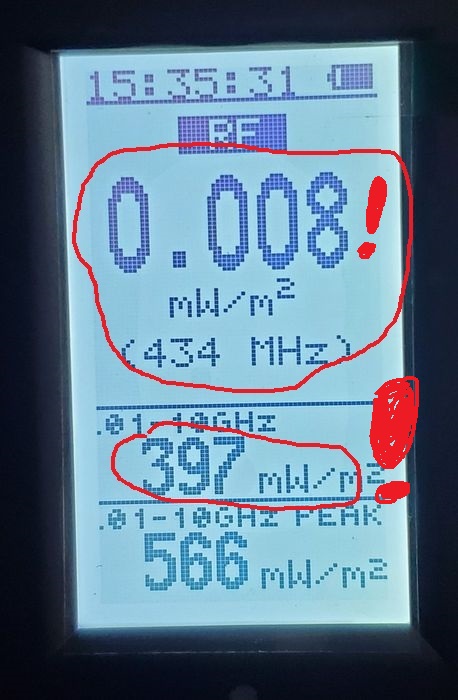
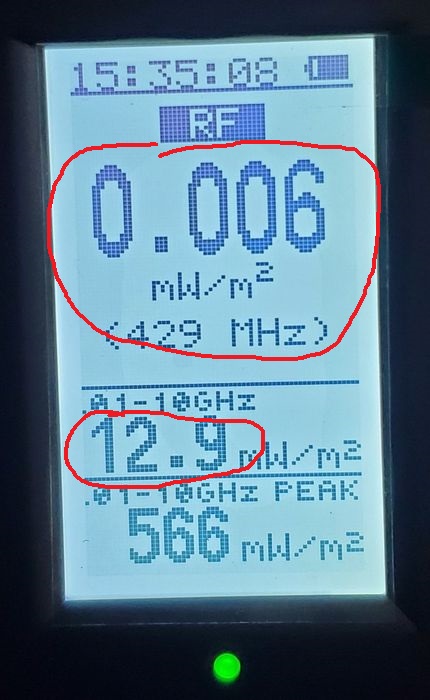

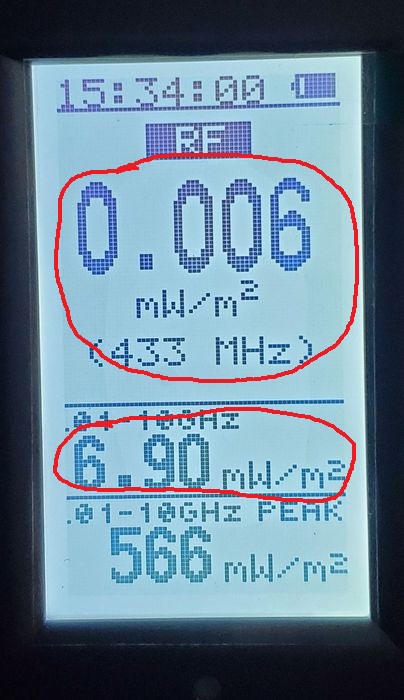
|
Edited by - Palihh on 05/23/2024 09:47:01 |
 |
|
| Reply #2
Palihh
 
17 Posts |
 Posted - 05/23/2024 : 23:01:51 Posted - 05/23/2024 : 23:01:51


|
I found a respected EmfDev answer in this forum regarding “Vertical mode”. He answered like this:
the specific frequency that the RF in vertical mode only covers the 2.4-2.5GHz and 240-1040MHz.
If this information is still relevant today, then I don’t understand at all why such cropped information is needed? What is it for? The second field indicates the average value over the entire range. But if an average can be obtained, then it can be assumed that this average is calculated taking into account all the data for the entire section. Is not it?. But in this case, why not, having the entire range of such values, not display the current value in the upper field indicating the corresponding frequency in real time. This would be absolutely correct. But in this case, the data given in the top field only causes bewilderment and questions - WHY is there cropped and incomplete information there? |
 |
|
| Reply #3
Palihh
 
17 Posts |
 Posted - 05/24/2024 : 04:03:06 Posted - 05/24/2024 : 04:03:06


|
I think it is very strange that no one has yet agreed with me or supported me.
Is this quite obvious remark on the “Vertical mode” really not needed by anyone?
Does everyone really think like this:
it doesn’t matter what is shown in the top field, at least something is shown and it’s good... |
 |
|
| Reply #4
EmfDev
    
2379 Posts |
 Posted - 05/24/2024 : 16:19:46 Posted - 05/24/2024 : 16:19:46


|
| The second reading in vertical mode covers 10MHz to 10GHz that is why it is that high. There may be frequencies that was not detected by the spectrum analyzer chips and was detected by the 10MHz - 10GHz sensor. |
 |
|
| Reply #5
Palihh
 
17 Posts |
 Posted - 05/25/2024 : 00:09:31 Posted - 05/25/2024 : 00:09:31


|
Thank you for your answer.
But the essence of my question is different.
I understand what you said.
That in the second field the average value is indicated over the entire full spectrum (0.1-10 GHz) and the measurements seem to be captured more accurately there.
However, I was mainly asking about the values in the top field. I don't understand the purpose of this top field. What is shown there? Let me ask you about this again.
It seems that the sensors responsible for the values in the upper field do not record elevated or any other values throughout the entire range in real time (0.1-10 GHz) (but only in some parts of the range). And this is strange. In this case, the meaning of the truncated values in the top field is completely lost.
Indeed, in the second field the average value is given over the entire range (0.1-10 GHz). This means that in order to average all the values, you need to have them somewhere. So, I conclude that all values are calculated somewhere. And from them the average value is displayed in the average field. So it would make sense for the top box to show the current maximum value in real time across the entire range!
And then this “Vertical mode” becomes organic and completely self-sufficient and informative. Is not it so?
But now the top field is nothing.
So, let me summarize.
1.Top field - (must be done as in the "RF Browser" mode). That is, the top field should display constantly in real time the maximum value over the entire frequency range (0.1-10 GHz) and the frequency at which this value is recorded should be indicated below (update time, for example, every second)
2.Second field - Average value over the entire range. Like now.
3. Third field - Maximum peak over the entire range. Like now.
Is it possible to hope for a full-fledged “Vertical mode” in new firmware?
Thank you.
Because currently, right now, it all works like this:
Here is the signal from the walkie-talkie in transmission mode: (Both in the “RF Browser” mode and in the “Vertical mode” the values are shown more or less correctly. In any case, they are there.
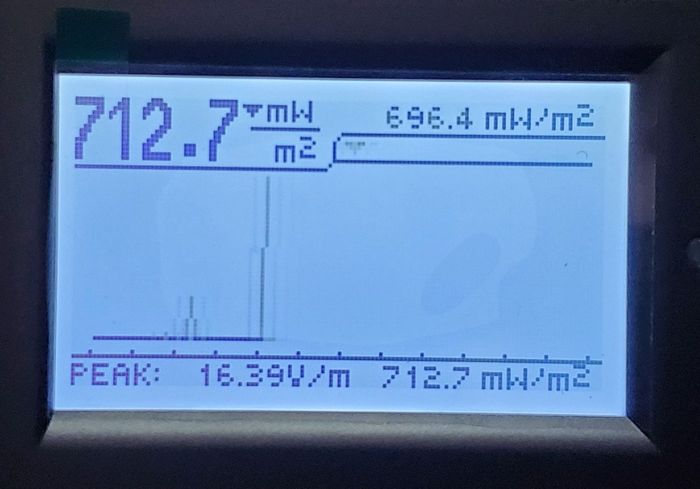

And here is the data from the influence of the smartphone: (In the “RF Browser” mode, these values are there, but in the “Vertical mode” there is nothing).
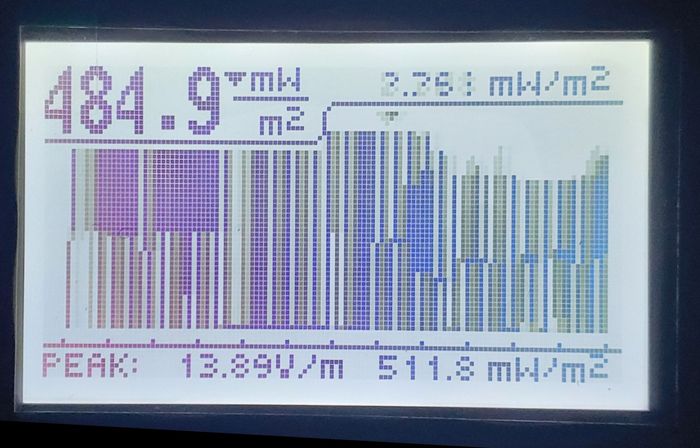

You cannot but agree with me that this is not correct. The “vertical mode” turns out to be not fully developed. The top field cannot be fully used, but it could be completed and it would turn out to be a piece of candy! I would like to change this in new firmware. Sincerely.
----
So, I have a question for the hon EmfDev .
Due to the fact that the “Vertical Mode RF” has not been finalized and cannot be used normally in its present form, can we expect that this problem will be solved in the next firmware and the “Vertical Mode RF” will become useful and convenient, because in this form How is he completely useless now?
Thank you.
|
Edited by - Palihh on 05/25/2024 20:42:56 |
 |
|
| Reply #6
Palihh
 
17 Posts |
 Posted - 05/27/2024 : 04:39:32 Posted - 05/27/2024 : 04:39:32


|
I, and many, I think, are waiting for an answer.
Is it possible in new firmware to make the “Vertical mode (RF)” (specifically, we are talking about the top field) full-fledged and more convenient, taking into account all of the above.
Waiting for a response. |
 |
|
| Reply #7
Palihh
 
17 Posts |
 Posted - 05/29/2024 : 02:11:47 Posted - 05/29/2024 : 02:11:47


|
| ? |
 |
|
| Reply #8
EmfDev
    
2379 Posts |
 Posted - 05/29/2024 : 12:51:04 Posted - 05/29/2024 : 12:51:04


|
| When the top field is low, while the mid field is high, that means the device detected a frequency that cannot be determined by the device spectrum feature. But the frequency is still within 10MHz - 10GHz. |
 |
|
| Reply #9
EmfDev
    
2379 Posts |
 Posted - 05/29/2024 : 12:51:44 Posted - 05/29/2024 : 12:51:44


|
| The frequencies that can be determined by the top field are the ones found in spectrum analyzer mode. |
 |
|
| Reply #10
Palihh
 
17 Posts |
 Posted - 05/29/2024 : 20:53:13 Posted - 05/29/2024 : 20:53:13


|
Yes, I understand what you are talking about.
But in this case, a reasonable question immediately arises: Why is such a so inferior cut down “Spectrum Analyzer Mode” needed?
What features does it provide?
How can it be used?
After all, this “Spectrum Analyzer Mode” does not analyze the full spectrum range of 0.1-1 GHz!!!
It analyzes some parts of the range, but not the full range!
What's the point of this? He sees something, he doesn’t see something!
Why was this done?
Here "Mode RF Browser" is implemented perfectly!
It analyzes the entire full range of 0.1-1GHz, and displays this data with a graph.
I think it would be correct to make the top field in the “Vertical RF Mode” similar to the "Mode RF Browser", so that the current maximum measurement data is displayed there, indicating the frequency at which the measurement was made across the entire, I repeat, range, without gaps, that is, the way it is implemented in "Mode RF Browser"!
And the absolutely unnecessary Stripped-down “Spectrum Analyzer Mode” must be removed from the top field in the “Vertical Mode RF ”. because in such a damaged and unclaimed form it is not needed at all("Spectrum Analyzer Mode" can remain in the upper field only in one case - if it covers the full spectrum range of 0.1-1 GHz, and works adequately, detecting all changes, as happens in the "Mode RF Browser". And so the way it works now, it's simply not good enough! It just takes up space in the top margin without providing any useful information!).
In short, don't you agree that my proposal is absolutely common sense and correct?
What needs to be replaced by an incomprehensible half-mode with a normally and fully functioning mode,similar to mode "Mode RF Browser"?
Or upgrade the half-mode “Vertical Mode RF ” (in the upper field of the mode) to a full-fledged mode!
With all changes detected across the entire 0.1-10 GHz range.
In any case, it is necessary to take certain measures to correct the situation with the unclear display of information in the upper field of the mode.
Leaving everything as it is now would be completely wrong! |
Edited by - Palihh on 05/29/2024 21:58:29 |
 |
|
| Reply #11
EmfDev
    
2379 Posts |
 Posted - 06/03/2024 : 09:46:48 Posted - 06/03/2024 : 09:46:48


|
| The spectrum analyzer mode is an extra feature to the EMF-390. For some advanced users, they want to detect specific frequencies like 2.4-2.5G so they just use that mode in order to check. A spectrum analyzer that can detect all bands from DC-10GHz is going to be very expensive. |
 |
|
| Reply #12
Palihh
 
17 Posts |
 Posted - 06/04/2024 : 07:59:56 Posted - 06/04/2024 : 07:59:56


|
| It is a pity that this top field is currently used so poorly and incompletely, and that in this top field it will not be possible to duplicate information from the “RF Browser” mode, only in a different form, indicating the measurement frequency. |
 |
|
| Reply #13
Tido

2 Posts |
 Posted - 06/20/2024 : 13:37:38 Posted - 06/20/2024 : 13:37:38


|
I've read through all the messages, and now I have a much clearer understanding of vertical mode and how RF signals outside the normal spectrum are detected. Thank you!
However, I still disagree, the overall design is quite good. The only improvement I could suggest, or would love to have, is a separate alarm settings for the 01-10 GHz range, along with blinking LED indicators for values exceeding the set alarm. Additionally permant, active in the background, audio/sound option specifically for the 01-10 GHz range played on any rf view, would be fantastic, or something like an alarm priority that could be selected only in vertical mode.
Personally, I find the ghost alarm sound mode very helpful for pinpointing signals. However, I understand that achieving similar functionality for the 01-10 GHz RF signal likely requires a dedicated spectrometer or some kind of decoding, which isn't currently technically possible, right?
Therefore, at least a siren or a distinct beep sound at a different frequency from the regular beep for 01-10 GHz RF values would be a great improvement that I would love to have.
For me, the main and sub positions are making good use of the available information. Maybe a small icon next to the sub 01-10 GHz RF signal view(sub view, right corner) showing "normal," "high," "extreme," and so on, like in the all-in-one view. It would be a great extra, that i would love to see and that also could help making it clearer how the sub RV view in vertical mode works. |
Edited by - Tido on 06/20/2024 14:02:36 |
 |
|
| |
 Topic Topic  |
|
|
|

